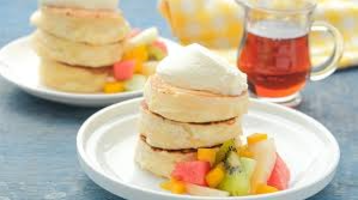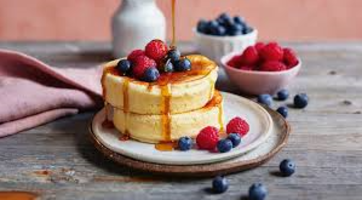Have you ever seen those impossibly tall, jiggly pancakes that seem to defy gravity? Those cloud-like creations are Japanese souffle pancakes, and they’ve become a worldwide sensation for good reason. These aren’t your typical breakfast pancakes – they’re a delightful culinary experience that combines the comfort of traditional pancakes with the airy lightness of a souffle.
While these pancakes might look intimidating, with the right technique and a bit of patience, you’ll be creating these showstopping treats at home. Unlike regular pancake recipes that produce flat, dense results, this technique creates pancakes that are light as air while still satisfying your sweet tooth.
So, roll up your sleeves, grab your mixing bowls, and let’s bring a touch of Japanese cafe culture to your breakfast table.

What Makes Japanese Souffle Pancakes Special?
Let’s understand what makes these pancakes so unique:
Origin Story
These cloud-like pancakes first emerged in Japan around 2014, inspired by the country’s love for fluffy, jiggly textures in desserts. They quickly became a staple in Japanese cafes before spreading internationally through social media.
Texture Revolution
Unlike traditional pancakes, Japanese souffle pancakes have an incredibly soft, souffle-like consistency that literally jiggles on the plate. Like with a souffle, this texture is achieved by adding whipped egg whites to the batter.
Visual Appeal
Their impressive height (often stacked 2-3 inches tall) and gentle wobble make them highly photogenic and perfect for social media sharing. The visual experience is half the enjoyment!
Flavor Profile
Despite their cloud-like texture, these pancakes deliver a rich flavor with hints of vanilla and a subtle sweetness that pairs beautifully with toppings like fresh fruit, whipped cream, and maple syrup.
Essential Equipment for Perfect Japanese Souffle Pancakes
Before starting your Japanese souffle pancake journey, gather these kitchen tools:
- Hand Mixer or Stand Mixer
- Metal Ring Molds
- Non-Stick Skillet with Lid
- Kitchen Scale
- Offset Spatula
- Thermometer
- Fine Mesh Sieve
Ingredients for Japanese Souffle Pancakes For 6 Pancakes (2 servings)

Egg Component:
- 3 large eggs, separated
- 2 tablespoons whole milk, room temperature
- ¼ teaspoon vanilla extract
- ¼ cup granulated sugar, divided
Dry Ingredients:
- ⅓ cup cake flour
- ½ teaspoon baking powder
- Pinch of salt
For Cooking:
- 1 tablespoon neutral oil or butter
- 2 tablespoons water (for steaming)
For Serving:
- Powdered sugar for dusting
- Fresh berries
- Maple syrup or honey
- Whipped cream
Preparation Steps
Prepare Your Workspace
Before diving into the recipe, organize your workspace. Having everything ready will make the process smoother since timing is crucial for these pancakes. Allow eggs to come to room temperature for optimal volume when whipped.
Mix Dry Ingredients
Sift the cake flour, baking powder, and salt together in a bowl. Sifting is essential for removing any lumps that might weigh down your batter. Set aside.
Separate Eggs Carefully
Make sure the whites of your eggs are free of yolk, since even a tiny bit of yolk might interfere with the proper whipping of the whites. Place egg whites in a clean, dry bowl (preferably metal or glass) and allow them to come to room temperature for maximum volume.
Creating the Batter
Mix Egg Yolk Base
Whisk the egg yolks in a medium bowl until they are smooth, then, add in milk and vanilla essence until thoroughly blended, then, you need (2 tablespoons) of sugar but add only half at this point, and mix until the mixture is pale yellow and somewhat thickened.
Add the Dry Ingredients
Using a spatula, gently add the dry ingredients into the egg yolk mixture until they are just combined after gradually sifting them in. Be careful not to overmix, which can develop gluten and create dense pancakes. The batter will be thick and somewhat lumpy at this stage – this is normal.
Whip Egg Whites
Start beating the egg whites on medium speed in another bowl. When they become foamy, gradually add the remaining sugar (from step 1) while continuing to whip. Increase speed to medium-high and whip until stiff, glossy peaks form – when you lift the beater, the peaks should stand straight up without curling over. This typically takes 3-4 minutes.
Fold in Whipped Egg Whites
This is the most crucial step for achieving that signature souffle texture. Add one-third of the whipped egg whites to the yolk mixture and fold gently to lighten the batter.
Next, add in the remaining egg whites in two batches using a big spatula in a center-to-side and bottom-to-top motion. The egg whites must be included without becoming deflated.

Making Japanese Souffle Pancakes
Prepare Your Pan
Heat a non-stick skillet over very low heat. When cooking souffle pancakes, lower heat is better than higher heat – aim for around 300°F (150°C). A heat diffuser can be used if your stove runs hot. Lightly grease your ring molds and place them in the pan. Let them warm up for approximately one minute.
Cook the First Side
Fill each mold approximately halfway with batter (about 3–4 tablespoons per mold). The batter should come up about ½ inch in each mold. Add 1-2 teaspoons of water to the side of the pan (not directly on the pancakes) and quickly cover with a lid. The steam created helps cook the pancakes evenly.
Cook until the tops start to set and the bottoms are golden brown, which takes about 5 to 6 minutes. You’ll notice bubbles forming on the surface, and the tops will appear less glossy.
Flip Carefully
This is the trickiest part! Using an offset spatula and tongs (or another spatula), carefully flip each pancake while keeping it in its ring mold. If the pancake sticks to the mold, gently run a thin knife around the edge before flipping.
Cook the Second Side
Add another tablespoon of water to the pan, cover again, and cook for an additional 4-5 minutes until the second side is golden and the centers are fully cooked.
Remove and Serve
After turning off the heat, carefully remove the ring molds with tongs. If they stick, run a thin knife around the edges. Quickly move the pancakes to serving plates. Stack them if desired (typically served in stacks of 2-3) and serve with your chosen toppings while still warm.
Tips for Souffle Pancake Success
Temperature Control
Japanese souffle pancakes require exact temperature control for proper rising and cooking:
- Too hot: Before the interior cooks, the exterior will turn brown.
- Too cool: The pancakes won’t rise properly and may collapse
Throughout the cooking period, keep a low and steady heat. Reduce the heat even more if you see too much browning.
Timing Is Everything
Once your egg whites are whipped and folded into the batter, work quickly. Your pancakes will become less fluffy as the air bubbles in the batter gradually start to deflate.
Patience Pays Off
Resist the urge to rush the cooking process or to frequently lift the lid to check progress. Each time you lift the lid, you release steam and heat that helps cook the pancakes evenly.
Gentle Technique
Throughout the entire process – from folding in egg whites to flipping the pancakes – gentle handling is essential. Rough movements will deflate the air bubbles that create the souffle-like texture.
Troubleshooting Common Issues
Pancakes Collapse After Cooking
- Possible causes: Undercooked centers, egg whites not whipped to stiff peaks, overmixing during folding
- Solution: Cook pancakes fully before removing from heat, ensure proper egg white consistency, and fold batter more gently
Uneven Rising
- Possible causes: Uneven heat distribution, uneven folding of egg whites
- Solution: Rotate pan during cooking if your stove has hot spots, and ensure more thorough (but still gentle) folding of ingredients
Pancakes Stick to Molds
- Possible causes: Insufficient greasing, cooking temperature too high
- Solution: Thoroughly grease molds, especially the bottom edges, and lower cooking temperature
Pancakes Brown Too Quickly
- Possible causes: The pan is too near the heat source and the heat is too high
- Solution: Lower heat further and consider using a heat diffuser if your stove runs hot
Batter Too Runny
- Possible causes: Incorrect measurements, egg whites not whipped enough
- Solution: Ensure precise measurements and whip egg whites until they form stiff, glossy peaks that hold their shape
Storage and Make-Ahead Tips
Japanese souffle pancakes are best enjoyed immediately after cooking, as they will gradually deflate and lose their signature texture, but if you have to get parts ready in advance:
Dry Ingredients: Can be mixed and stored in an airtight container for up to a week.
Egg Separation: Eggs can be separated and stored in the refrigerator for a few hours before cooking (keep whites and yolks in separate containers).
Leftover Pancakes: While not ideal, leftover pancakes can be stored in an airtight container in the refrigerator for up to 24 hours. Reheat gently in the microwave for 15-20 seconds before serving. Note that they will not maintain their original height and fluffiness.
Creative Variations on Japanese Souffle Pancakes
While traditional Japanese souffle pancakes are magnificent on their own, here are some creative variations to explore:
Matcha Souffle Pancakes Add 1-2 teaspoons of high-quality matcha powder to the dry ingredients for a beautiful green hue and subtle earthy flavor.
Chocolate Souffle Pancakes Replace 1 tablespoon of cake flour with cocoa powder for a chocolate version, or fold mini chocolate chips into the batter.
Citrus Souffle Pancakes Add 1 teaspoon of lemon or orange zest to the egg yolk mixture for a bright, refreshing flavor.
Berry-Stuffed Souffle Pancakes Place a few small berries in the center of each pancake after pouring the batter into the molds.
Black Sesame Souffle Pancakes Add 1 tablespoon of ground black sesame seeds to the dry ingredients for a nutty flavor and dramatic color.
FAQs
Can I make Japanese souffle pancakes without ring molds?
Yes, you can make a simplified version without ring molds, though they won’t achieve the same height. Simply spoon the batter onto a low-heat pan in small circles and cook covered. They’ll be fluffier than regular pancakes but not as tall as traditional souffle pancakes.
Why do my Japanese souffle pancakes deflate after cooking?
Souffle pancakes naturally deflate somewhat after cooking as they cool. However, excessive deflation usually indicates undercooking, overmixing the batter, or not whipping the egg whites sufficiently. Make sure to cook them thoroughly on low heat and handle the batter gently.
Can I prepare the batter ahead of time?
Unfortunately, the batter should be used immediately after preparation. The whipped egg whites will begin to deflate over time, resulting in less fluffy pancakes. The entire process from mixing to cooking should happen without delay for best results.
Are Japanese souffle pancakes gluten-free? T
raditional souffle pancakes contain cake flour, which is not gluten-free. However, you can attempt to make them with a good quality gluten-free flour blend, though the texture may differ slightly from the original.
How can I tell when Japanese souffle pancakes are fully cooked?
Properly cooked souffle pancakes should be golden brown on both sides and should spring back slightly when gently pressed in the center. If you’re uncertain, you can insert a toothpick into the center – it should come out clean or with a few moist crumbs.
Conclusion…
Mastering Japanese souffle pancakes at home is truly a rewarding culinary achievement. While they require more attention and technique than traditional pancakes, the results are well worth the effort. That signature wobble, cloud-like texture, and delicate sweetness make Japanese souffle pancakes an unforgettable breakfast or dessert experience.
The look of wonder as they wobble on the plate is matched only by the smile that appears after the first heavenly bite. So, gather your ingredients, prepare your workspace, and embark on your Japanese souffle pancake journey.
